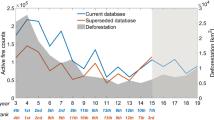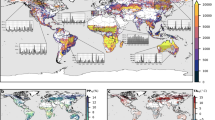Abstract
Landscape fires are key in African ecosystems1,2,3 and the continent is responsible for ·70% of global burned area and ·50% of fire-related carbon emissions4,5. Fires are mostly human ignited, but precipitation patterns govern when and where fires can occur6. The relative role of humans and precipitation in driving the spatio-temporal variability in burned area is not fully disentangled but is required to predict future burned area7,8. Over 2001–2012, observations indicate strong but opposing trends in the African hemispheres4. Here we use satellite data and statistical modelling and show that changes in precipitation, driven by the El Niño/Southern Oscillation (ENSO), which changed from El Niño to La Niña dominance over our study period, contributed substantially (51%) to the upward trend over southern Africa. This also contributed to the downward trend over northern Africa (24%), but here rapid demographic and socio-economic changes were almost as important (20%), mainly due to conversion of savannah into cropland, muting burned area. Given the economic perspective of Africa and the oscillative nature of ENSO, future African savannah burned area will probably decline. Combined with increasing global forest fire activity due to climate change9,10,11, our results indicate a potential shift in global pyrogeography from being savannah dominated to being forest dominated.
This is a preview of subscription content, access via your institution
Access options
Subscribe to this journal
Receive 12 print issues and online access
$209.00 per year
only $17.42 per issue
Buy this article
- Purchase on Springer Link
- Instant access to full article PDF
Prices may be subject to local taxes which are calculated during checkout



Similar content being viewed by others
References
Scholes, R. J. & Archer, S. R. Tree-grass interactions in savannas. Annu. Rev. Ecol. Syst. 28, 517–544 (1997).
Bond, W. J., Woodward, F. I. & Midgley, G. F. The global distribution of ecosystems in a world without fire. New Phytol. 165, 525–537 (2005).
Bowman, D. M. J. S. et al. Fire in the Earth system. Science 324, 481–484 (2009).
Giglio, L., Randerson, J. T. & van der Werf, G. R. Analysis of daily, monthly, and annual burned area using the fourth-generation global fire emissions database (GFED4). J. Geophys. Res. 118, 317–328 (2013).
Van der Werf, G. R. et al. Global fire emissions and the contribution of deforestation, savanna, forest, agricultural, and peat fires (1997–2009). Atmos. Chem. Phys. 10, 11707–11735 (2010).
Archibald, S., Roy, D. P., van Wilgen, B. W. & Scholes, R. J. What limits fire? An examination of drivers of burnt area in Southern Africa. Glob. Change Biol. 15, 613–630 (2009).
Pechony, O. & Shindell, D. T. Driving forces of global wildfires over the past millennium and the forthcoming century. Proc. Natl Acad. Sci. USA 107, 19167–19170 (2010).
Kloster, S., Mahowald, N. M., Randerson, J. T. & Lawrence, P. J. The impacts of climate, land use, and demography on fires during the 21st century simulated by CLM-CN. Biogeosciences 9, 509–525 (2012).
Kasischke, E. S., Christensen, N. L. Jr & Stocks, B. J. Fire, global warming, and the carbon balance of boreal forests. Ecol. Appl. 5, 437–451 (1995).
Westerling, A. L., Hidalgo, H. G., Cayan, D. R. & Swetnam, T. W. Warming and earlier spring increase western US forest wildfire activity. Science 313, 940–943 (2006).
Malhi, Y., Roberts, J. T., Betts, R. A. & Killeen, T. J. Climate change, deforestation, and the fate of the Amazon. Science 319, 169–172 (2008).
Beerling, D. J. & Osborne, C. P. The origin of the savanna biome. Glob. Change Biol. 12, 2023–2031 (2006).
Van der Werf, G. R., Randerson, J. T., Giglio, L., Gobron, N. & Dolman, A. J. Climate controls on the variability of fires in the tropics and subtropics. Glob. Biogeochem. Cycles 22, GB3028 (2008).
Nicholson, S. E. & Grist, J. P. The seasonal evolution of the atmospheric circulation over West Africa and Equatorial Africa. J. Clim. 16, 1013–1030 (2003).
Daniau, A-L. et al. Orbital-scale climate forcing of grassland burning in southern Africa. Proc. Natl Acad. Sci. USA 110, 5069–5073 (2013).
Grégoire, J. M. et al. Effect of land-cover change on Africa’s burnt area. Int. J. Wildl. Fire 22, 107–120 (2013).
Archibald, S., Scholes, R. J., Roy, D. P., Roberts, G. & Boschetti, L. Southern African fire regimes as revealed by remote sensing. Int. J. Wildl. Fire 19, 861–878 (2010).
Shaffer, L. J. Indigenous fire use to manage savanna landscapes in Southern Mozambique. Fire Ecol. 6, 43–59 (2010).
Turner, M. D. The new pastoral development paradigm: Engaging the realities of property institutions and livestock mobility in dryland Africa. Soc. Nature Resour. An. Int. J. 24, 469–484 (2011).
Tiffen, M. Urbanization: Impacts on the evolution of “mixed farming” systems in Sub-Saharan Africa. Exp. Agric. 42, 259–287 (2006).
Roy, D. P. & Boschetti, L. Southern Africa validation of the MODIS, L3JRC, and GlobCarbon burned-area products. IEEE Trans. Geosci. Remote Sensing 47, 1032–1044 (2009).
Giglio, L., Loboda, T., Roy, D. P., Quayle, B. & Justice, C. O. An active-fire based burned area mapping algorithm for the MODIS sensor. Remote Sensing Environ. 113, 408–420 (2009).
Huffman, G. J. et al. The TRMM Multisatellite Precipitation Analysis (TMPA): Quasi-global, multiyear, combined-sensor precipitation estimates at fine scales. J. Hydrometeorol. 8, 38–55 (2007).
Friedl, M. A. et al. Global land cover mapping from MODIS: Algorithms and early results. Remote Sensing Environ. 83, 287–302 (2002).
Archibald, S., Nickless, A., Govender, N., Scholes, R. J. & Lehsten, V. Climate and the inter-annual variability of fire in southern Africa: A meta-analysis using long-term field data and satellite-derived burnt area data. Glob. Ecol. Biogeogr. 19, 794–809 (2010).
Anyamba, A., Tucker, C. J. & Eastman, J. R. NDVI anomaly patterns over Africa during the 1997/98 ENSO warm event. Int. J. Remote Sensing 22, 1847–1859 (2001).
Dai, A. & Wigley, T. M. L. Global patterns of ENSO-induced precipitation. Geophys. Res. Lett. 27, 1283–1286 (2000).
Wolter, K. & Timlin, M. S. Measuring the strength of ENSO events: How does 1997/98 rank? Weather 53, 315–324 (1998).
Marlon, J. R. et al. Climate and human influences on global biomass burning over the past two millennia. Nature Geosci. 1, 697–702 (2008).
Alexandratos, N. & Bruinsma, J. World Agriculture towards 2030/2050: The 2012 Revision 147 (Food and Agriculture Organization, 2012).
Acknowledgements
We would like to thank P. Castellanos and A. Meesters for their helpful suggestions and all data providers and agencies for making their data publicly available. N.A. received financial support from the EU FP7 MACC-II project (contract number 218793) and G.R.v.d.W. is supported by the European Research Council (contract number 280061).
Author information
Authors and Affiliations
Contributions
N.A. and G.R.v.d.W. designed the research, N.A. conducted the research, and N.A. and G.R.v.d.W. wrote the paper.
Corresponding author
Ethics declarations
Competing interests
The authors declare no competing financial interests.
Supplementary information
Rights and permissions
About this article
Cite this article
Andela, N., van der Werf, G. Recent trends in African fires driven by cropland expansion and El Niño to La Niña transition. Nature Clim Change 4, 791–795 (2014). https://doi.org/10.1038/nclimate2313
Received:
Accepted:
Published:
Issue Date:
DOI: https://doi.org/10.1038/nclimate2313
This article is cited by
-
Extreme fire weather in Chile driven by climate change and El Niño–Southern Oscillation (ENSO)
Scientific Reports (2024)
-
Boreal–Arctic wetland methane emissions modulated by warming and vegetation activity
Nature Climate Change (2024)
-
Impact of the El Niño on Fire Dynamics on the African Continent
Earth Systems and Environment (2024)
-
Assessing changes in global fire regimes
Fire Ecology (2024)
-
Humans and climate modulate fire activity across Ethiopia
Fire Ecology (2023)



